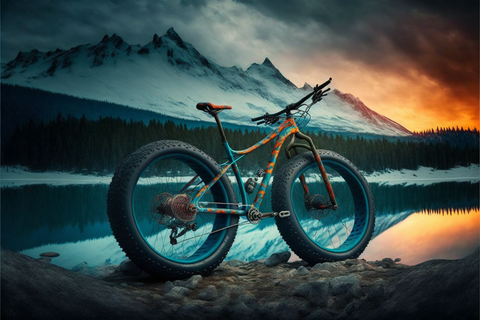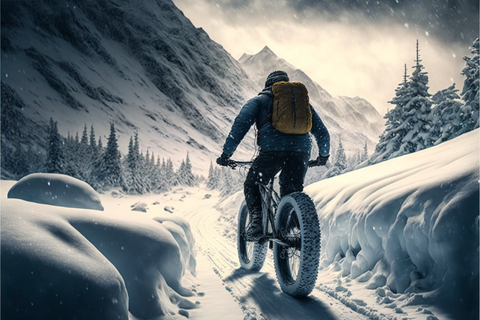Fat tire bikes have become increasingly popular in recent years, and for good reason. These fat bikes offer more stability and grip than traditional mountain bikes, making them a great choice for off-road riding. But what about riding in the snow? Are fat tire bikes good in snow? The answer is definitely yes! Fat tire bikes are designed with wide tires that provide extra grip and stability on slippery surfaces, making them an ideal choice for riding in the snow.
In this article, we’ll explain why fat tire bikes are great for snow and provide some tips for getting the most out of your fat tire bike in the snow.
Types of Fat Tire Bikes - Fat Biking
If you're looking for a reliable way to bike in the snow, then a fat tire bike may be the perfect choice for you.
Fat tire bikes are designed to provide more stability and better traction in snowy conditions, allowing you to enjoy your winter rides with greater ease and safety.
But with so many types of fat tire bikes available, it can be difficult to decide which one is best for you. Fat tire bikes come in a variety of styles, from traditional mountain bikes to electric models. Traditional mountain bikes with fat tires provide excellent stability and traction for riding over snow and ice. These bikes are usually heavier than other types of bikes, which can help you maintain control.
Mountain Bikes
These bikes are an increasingly popular choice for winter riders, due to their toughness and versatility. But do they fare well in the snow? Are fat tire bikes good in snow? The short answer is: yes! Fat tire mountain bikes are actually built for use in snowy and icy conditions.
The tires are wider than regular mountain bike tires, and their design gives you added stability and grip on slippery surfaces.
This makes them great for use in snowy and icy terrain.
The main downside to using a fat tire bike in the snow is that it can be slightly slower.

All-Terrain Bikes
If you’re looking for a bike that can handle all terrains, then a fat tire bike may be the perfect choice for you.
Fat tire bikes are designed to provide excellent traction over a variety of surfaces, including wet or dry roads, snow, and even light off-road conditions.
This makes them an ideal option for those who live in areas where the weather can be unpredictable and snow is a common occurrence.
So, the question remains: are fat tire bikes good in snow?
The short answer is yes! Fat tire bikes are designed to handle many different conditions, including snow, and they can provide a comfortable ride.
Snow Bikes for Winter
As winter approaches, many cyclists start to look for bikes that can make riding on snow easier. Fat tire bikes, also known as snow bikes, are a great option for navigating winter terrain. With their huge tires and wide contact patch, fat tire bikes are well-suited for tackling snow, wet terrain, and off-road trails. When it comes to snow, fat tire bikes have a definite advantage. Their larger tires provide improved grip in slippery conditions, making them a great option for riding on snow and icy surfaces. Even on flat terrain, the wider tires make it easier to maintain traction and a steady speed, reducing the risk of slips and falls. Fat tire bikes are also great for more experienced riders.
The Benefits of Riding a Fat Tire Bike in the Snow
Winter is here and with it comes the snow. For avid cyclists, the thought of snow can be disheartening. After all, who wants to endure a cold, slippery ride in unfamiliar terrain? But with the growing popularity of fat tire bikes, winter doesn’t have to be a time for hibernating. Fat tire bikes are an excellent choice for riding in the snow. Their large tires allow for more grip, giving cyclists better control and stability. The wide tread also helps disperse the impact of obstacles like rocks, roots, and ruts, making them more comfortable for riders. Additionally, fat tire bikes are designed to reduce vibration, which can be a major factor in cold-weather rides.
Greater Grip
Fat tire bikes are designed to provide cyclists with greater stability and traction when riding on softer and less stable surfaces. The wider tires of a fat tire bike spread out the weight of the bike and rider over a larger surface area, allowing it to more easily stay atop snow and other soft surfaces.
The increased contact area also allows for more grip, helping cyclists stay upright when riding in slippery conditions.
Stability
When it comes to cycling in the snow, stability is a key factor in both comfort and safety. Fat tire bikes offer an ideal solution for those who plan on taking their biking adventures off the beaten path, especially in colder climates. Fat tire bikes are designed with thicker tires than standard bicycles, which gives them increased stability on snow and icy terrain.
The wide tires also provide more surface contact with the ground, allowing for better traction. This makes it easier to make turns and stay upright in even the most challenging weather conditions. In addition to the improved grip, the wider tires help to absorb any shock that is encountered while riding over bumps and obstacles. This helps to ensure a smoother, more comfortable ride.
Comfort & Control - Fat Tires
When it comes to comfort, fat tire bikes are great in snow. Fat tire bikes have wide tires that provide extra cushioning and better traction, which makes them perfect for riding in snow and other rough terrains.
The wide tires also mean that these bikes absorb shocks more effectively.
The wider tires provide more stability and confidence when riding on snow and other slippery surfaces. The extra traction means you can climb hills and even ride in deep snow with ease and security. Furthermore, the extra cushioning means the ride is comfortable even when you’re riding for long periods.
Another benefit of fat tire bikes is that they are often equipped with a more upright seating position.
Summary
In conclusion, fat tire bikes are great for riding in the snow. The oversized tires give you more traction and stability, giving cyclists better control and balance when navigating snowy surfaces.
Additionally, fat bikes are designed with lower air pressures, which allows them to easily roll over loose snow without sinking into the powder.
When winter weather knocks at your door, don’t forget that investing in a fat tire bike is an excellent way to get out and enjoy the snow!

FAQ
What are the disadvantages of a fat bike?
While fat bikes are great for riding on snow, sand, and other difficult terrains, they can be difficult to maneuver on regular roads. This is one of the main fat bike disadvantage. They also require more effort to pedal due to their large, heavy tires. Additionally, they are more expensive than regular mountain bikes, and spare parts are harder to find.
Furthermore, fat bikes are not as efficient as regular mountain bikes when it comes to speed, and can be uncomfortable to ride for long periods. Lastly, fat bikes are not as maneuverable as regular mountain bikes, meaning that they are not suitable for riding on tight trails or in technical terrain. All in all, fat bikes have their advantages but also come with a few drawbacks that should be considered.
What is the best bike to ride in the snow?
The answer to this question depends on the type of terrain you’ll be tackling and your experience level. For those looking for a more versatile bike to ride in the snow, a fat bike is a great option. These bikes are designed with wide tires and low air pressure that helps them to float on top of the snow rather than sinking into it. If you’re an experienced rider, a mountain bike with studded tires can also be a great option for riding in the snow. These tires provide extra grip and stability, allowing you to tackle any terrain with confidence.
Can you ride a fat bike on ice?
Yes, you can! Fat bikes are designed to be ridden on snow and ice, as they have wide tires that provide extra grip and stability. The fat tires are also able to float on top of soft snow, allowing you to ride on terrain that would otherwise be inaccessible. The extra traction provided by the wide tires also makes it possible to ride on icy surfaces. However, you should be aware that riding on ice can be dangerous. It is important to wear the proper safety gear, such as a helmet and gloves, and to take extra precautions when riding on icy surfaces. Additionally, it is important to be aware of your surroundings and to be prepared for unexpected changes in the terrain.
ABOUT THE AUTHOR
Nurlana Alasgarli
Content Specialist
Nurlana Alasgarli is a professional copywriter with more than 6 years of creative writing experience. Having lived and experienced all over the world, there are many writing genres that Nurlana follows, including adventure, outdoor and winter sports. Nurlana brings life to content creation, captivating her readers.






